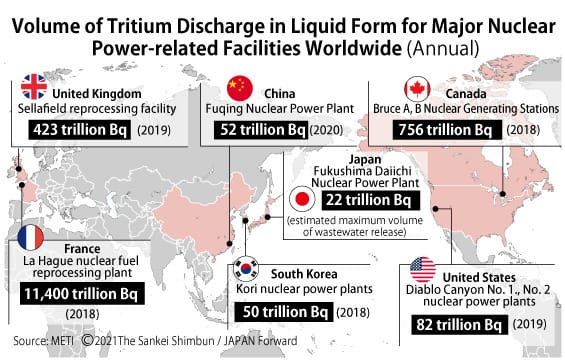Guest Op-Ed: The Fukushima Water Is Fine, Actually
As Tokyo Electric Power Company (Tepco) prepares to release treated Fukushima water, many environmental organizations decried the potential damage to human and marine life. The protestors’ main concern is the discharge of tritium, but is the water really dangerous?
First, let’s take a look at why Tepco is discharging the water in the first place. Following the 2011 earthquake and tsunami that led to the Fukushima accident, the plant was left with tons of radioactive water used to cool its nuclear fuel rods. After extensive study, the Japanese government decided the best way to protect the public and the environment was to treat and dilute the water until it became harmless, and then discharge it into the ocean.
As Tepco releases the water, the utility must adhere to rigorous safety standards. The water release is likely to take place over a period of 30 years, under great transparency.
And yet ever since Tepco’s announcement to release the treated water, people around the world have fearfully voiced opposition.
China claimed Japan could transfer “risk of nuclear contamination to the world.” Foreign Ministry spokesman Wang Webin added the discharge would be selfish and irresponsible. South Korea and China have already banned fish imports from around Fukushima.
On August 12, demonstrators in Seoul held signs saying “No radioactive material is safe for the sea,” demonstrating a lack of understanding of the clean, dilute nature of the discharge and that the ocean naturally contains large quantities of radiation.
Head of the National Federation of Fisheries Cooperative Associations Masanaobu Sakamaoto said that while many of his organization’s members accepted Japan’s assurances of the safety of the discharges, the group remains in opposition because the decision could negatively impact fishermen's livelihoods.
A state media company in China, People’s Daily, labeled the water “nuclear sewage.”
People within and outside of Japan have said they are afraid to consume fish from the region. On August 24, China banned seafood and “all aquatic products” from Japan.
So, why does the discharge inspire such fear? Two reasons: most people do not understand the very low risk, and people have been told Fukushima was a frightening disaster. It follows that its waste products would be perceived as scary and dangerous as well, even though Tepco has cleaned the water to exceptionally high standards set by the IAEA and other organizations.
Like what you’re reading? Click the button to get Grid Brief right in your inbox.
Fear of radiation has a history of causing more damage than radiation itself. For instance, for the people who had to relocate from Chernobyl, it was a “deeply traumatic experience” and mental health was the biggest health issue to emerge from the disaster, an international report concluded. Less than 100 people have died due to the accident, to date.
Much concern has been raised over the small traces of Tritium to be included in the discharge water, a mildly radioactive form of hydrogen that occurs naturally. It is so common that simply by living on Earth we are exposed to small amounts of Tritium everyday (without health consequences).
At low levels, tritium can be safely discharged. The levels that Tepco will release are below background radiation levels from simply living on earth–common sources of tritium include bananas, x-rays, and flying. Tritium also does not bioaccumulate, meaning eating exposed seafood will not hurt humans.
According to Australian National University lecturer Tony Irwin, nuclear plants across the globe have routinely discharged water containing tritium for more than 60 years without harming people or the environment, most at higher levels than the proposed 22 Tbq per year for Fukushima.
Those amounts of Tritium released have been proven to be safe. Heysham nuclear and Sellafield nuclear fuel processing plant, both in the U.K., release between 400-2,000 terabecquerels of tritium into the ocean each year (Fukushima plans to release 22 TBq). Diablo Canyon in California releases 84 TBq each year.

Plus, University of Portsmouth scientist Jim Smith says tritium is a weak emitter and is not very radiotoxic. In the case of Fukushima’s discharge water the risk to nations around the Pacific is “close to zero.”
Putting Fukushima’s water release in context can help elucidate its safety. Smith and a team of colleagues studied ecosystems and lakes in Chernobyl with thousands of times the concentration of radiation than what we can expect from the Fukushima discharges.
In Chernobyl, the group found thriving aquatic ecosystems and minimal impacts of radiation on aquatic organisms. Smith said the Japanese government’s plans are sound and the best path forward.
“Those making claims of major risks to the Pacific Ocean should consider the negative impact of their – I think scientifically baseless – claims on the communities in Japan who have been affected by the Fukushima accident,” Smith said.
The negative impact of such reckless fear mongering has serious implications for international diplomatic and economic relationships.
At the core of the contention and controversy is a misunderstanding of science. Politicians have a duty to listen to the premier scientists, and grasp an understanding of the issue. Capitalizing on fear, however, is often a sure route to securing or maintaining power. Average citizens are largely at the mercy of their leaders.
As Keiko Yamakazi, a Tokyo resident said, “What can anyone do? Ordinary people do not understand these things, and we have no way of being sure that it is safe to release it into the ocean, so all we can do is trust [the government].”
But we should trust the facts of the case. The International Atomic Energy Agency, a stringent regulator of nuclear energy around the world, after extensive monitoring, concluded Fukushima's water's impact on people and the environment will be “negligible.”
In summary, Fukushima’s water is safe. It is not something to worry about, and certainly not something to fight against.
Jack Austin is a writer, researcher, and journalist originally from Pittsburgh and based in Chicago.
